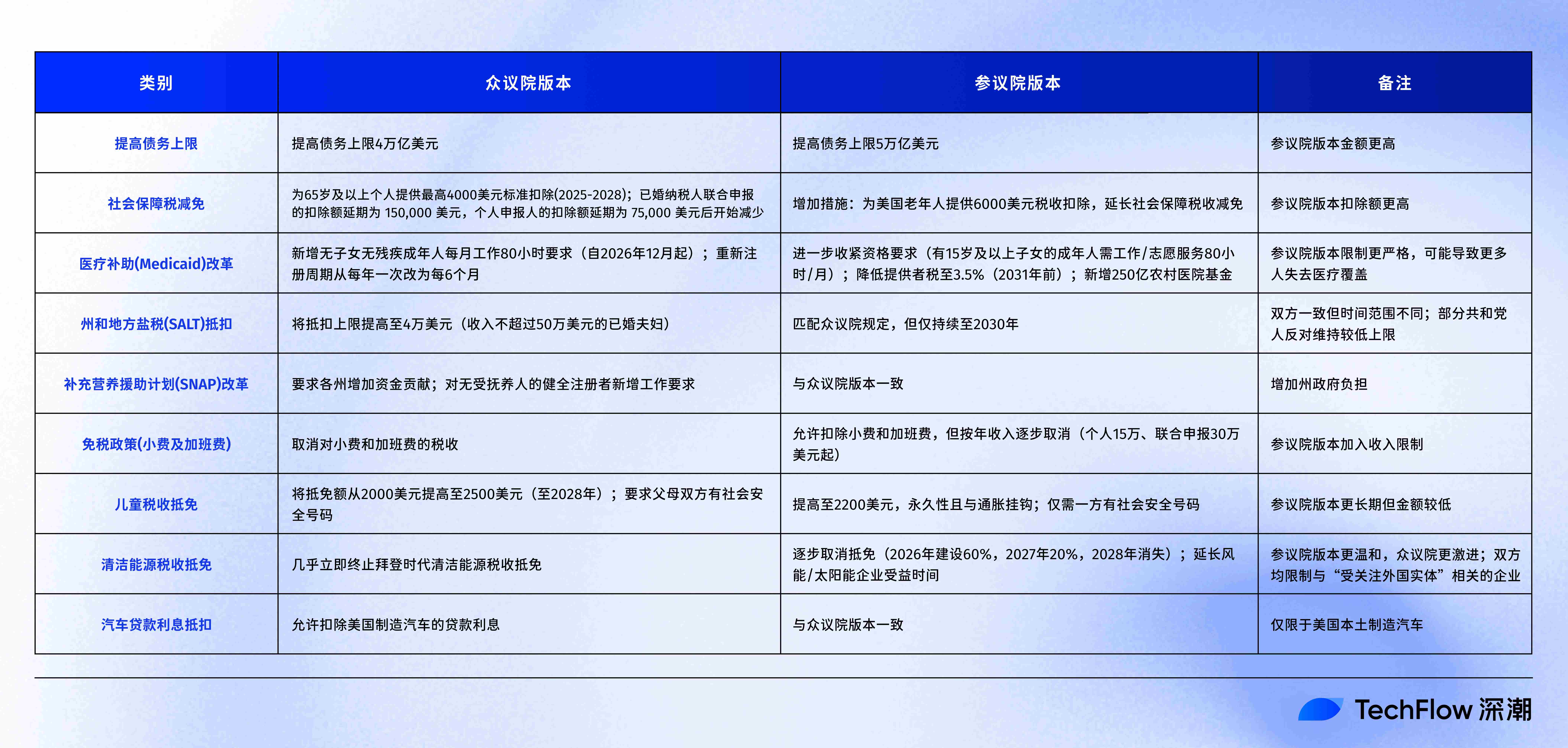Crypto wins again? An in-depth analysis of Trump’s “Big and Beautiful Bill”
$3.3 trillion in tax cuts, $1.13 trillion in spending cuts, 1,118 pages of bill text... A super bill called the One Big Beautiful Bill Act of 2025 (OBBBA) is reshaping the U.S. economic landscape, while also triggering new disputes between the two parties and even making Musk "furious."
On July 1, Musk posted on the social platform X that if the current "crazy spending bill" is passed (the "Big, Beautiful Bill"), he will set up the "America Party" the next day to protest the bill.
As a signature policy of Trump's second term, this bill can be described as "all-encompassing". It carries the Republican Party's ambitions and has also ignited fierce social controversy.
This article will deeply analyze the core content of the "Big and Beautiful Bill", the discussions it has sparked, and its potential impact on the crypto industry, to explore the full picture of this legislative storm.
Big Bill
The "Big, Beautiful Act" is a massive tax and spending bill promoted by US President Donald Trump in 2025. It covers six major areas: tax reform, health care reform, immigration policy, defense budget, energy policy, and education and welfare reform.
As the signature legislation of Trump's second term, it seeks to stimulate the economy through massive tax cuts, spending increases and policy adjustments, while addressing issues such as finance, immigration and national security.
The bill is 1,118 pages long, contains 237,327 words, and involves many complex clauses. It took 16 hours for the Senate to read the full text word by word during its deliberation. According to a BBC report on June 28, the core content of the "Big and Beautiful Bill" includes the following nine aspects:

According to the Tax Foundation, the "Big, Beautiful Act" is expected to reduce federal tax revenue by approximately $3.3 trillion (dynamic estimate) through tax cuts between 2025 and 2034, while increasing defense spending by approximately $150 billion, mainly for missile defense, ammunition and shipbuilding; at the same time, the bill will also significantly cut spending by approximately $1.13 trillion, including an $800 billion cut in Medicaid and $330 billion in savings from student loan program reforms.
In terms of economy, the bill will increase GDP by 0.6% in the long run, but reduce capital stock and pre-tax wages by 0.2% and 0.1% respectively, and increase employment by about 794,000 full-time jobs. Ultimately, the bill is expected to increase the deficit by $3.3 trillion between 2025 and 2034, and may bring fiscal sustainability risks in the long run due to high interest rates and the crowding-out effect of private investment.
In addition, the Congressional Budget Office (CBO) estimates that if the bill is implemented as the House version, the U.S. debt will increase by $2.4 trillion, the purchasing power of the bottom 10% of households will decrease by 4% between 2026 and 2034, and the purchasing power of the top 10% of households will increase by nearly 3%, sparking controversy over "robbing the poor to help the rich."
But the dispute goes far beyond that.
Big dispute
The "Big, Beautiful Act" was first announced by the U.S. House of Representatives Ways and Means Committee on May 12, 2025, and passed by the House of Representatives with a narrow margin of 215 to 214 votes on May 22. It passed a procedural vote in the Senate with a vote of 51 to 49 on June 28 and entered the formal review stage. It is expected to be signed into law by Trump before the U.S. Independence Day holiday on July 4. Due to its large scale, complex content and far-reaching impact, it has become the focus of American political and social opinion, triggering widespread controversy and heated discussions.
The bill's promoters see it as one of the core agendas of the Trump administration. Supporters believe that by cutting taxes and increasing defense spending, the bill will stimulate economic growth and enhance national security, especially as tough immigration and border policies have won support from some voters.
However, there are clear divisions within the Republican Party, with some hardliners demanding further cuts in social welfare spending, while moderates want to retain programs such as Medicaid, fearing that the bill may lead to an increase in the deficit and have an impact on low-income groups.
The bill passed by narrow margins in two votes on May 22 and June 28, demonstrating the divisions within the party.
In addition to the internal party disagreements, what is more widely known is the strong opposition to the bill by former head of the Department of Government Efficiency (DOGE) and Tesla founder Elon Musk. Based on the bill, Musk's verbal battle with President Trump is seen as a landmark event in the open break between the two. Since June 3, he has called it "huge, ridiculous, and disgusting", and after the latest procedural vote on June 28, he still firmly believes that this is a "political suicide" of the Republican Party.
Musk criticized the bill for a significant increase in the budget deficit, which is expected to increase by $600 billion in the next fiscal year and may reach $2.5 trillion in the next decade, which runs counter to the Trump administration's previously stated goal of cutting government spending.
In addition, the bill's provision to phase out tax credits for electric vehicles could have an adverse impact on Tesla, which has exacerbated Musk's dissatisfaction. He also proposed that the Federal Aviation Administration's (FAA) air traffic control system be handed over to its Starlink, but this proposal was not adopted, which also caused further controversy. Musk even threatened to fund Republicans who opposed the bill to challenge the election, highlighting his differences with Trump.
The Democrats unanimously opposed the bill, believing that it cut taxes for the rich by cutting medical and welfare support for low-income groups, which is a typical "robbing the poor to help the rich". Democratic leader Schumer demanded that the full text of the bill be read verbatim in the Senate to delay the vote, showing a strong resistance. Nobel Prize winner in economics Paul Krugman also criticized the bill as an unprecedented "robbing the poor to help the rich" , and pointed out that its combination with Trump's tariff policy will further damage the interests of the bottom 80% of households.
The reactions of the public and the media were polarized.
Supporters believe that the bill fulfills Trump's campaign promises, such as tax cuts and tough immigration policies, while opponents worry that it may exacerbate social inequality and debt burdens. Some users are also concerned about the digital identity and big data monitoring issues that may arise after the bill is passed, raising concerns about privacy protection.
From an international perspective, foreign investors are cautiously optimistic about the bill, believing that its stimulus measures may offset the negative impact of tariffs on GDP by about 1% to some extent. However, Section 899 of the bill, "Enforcement of Remedies for Unfair Foreign Taxes," involves retaliatory taxation, raising concerns about foreign investment incentives and the stability of the US dollar.
Overall, the passage of the "Big, Beautiful Act" has not only triggered widespread controversy at the political and social levels in the United States, but also had a profound impact on the international economic environment and investment confidence. Although the White House has issued an article in response to rumors and facts in response to most of the current controversies, the effectiveness of its future implementation remains to be seen.
What is encryption for?
On paper, the now-well-known provisions of the Big, American Act could weaken the power of federal courts, severely damage the health care system, increase the debt burden, intensify immigration enforcement, restrict foreign investment, increase air pollution, and increase the defense budget. Although the impact is wide-ranging, it has nothing to do with encryption.
This may not be the case. The passage of the “Big, Beautiful” Act (OBBBA) is likely to have far-reaching consequences for the cryptocurrency and financial industries.
The 2024 Republican Party platform of the United States has clearly written in clauses supporting cryptocurrencies, opposing excessive regulation, and supporting citizens' right to manage digital assets independently, reflecting the government's positive attitude towards the crypto industry. At the same time, the government's executive order to establish a "strategic bitcoin reserve" and include bitcoin in the national strategic reserve assets marks a fundamental improvement in the status of bitcoin.
The bill is expected to lead to an additional deficit of about $5 trillion for the US government. This scale of fiscal expansion may weaken the market's confidence in the US dollar and US debt. Foreign capital reduction of US debt holdings has become a structural trend. After the outflow of funds, it may flow into Asian stocks, gold and Bitcoin (BTC), further enhancing Bitcoin's status as a global store of value asset, especially in the context of Bitcoin being included in the US strategic reserve assets.
At the same time, the tax cuts and fiscal stimulus measures in the bill have created a more relaxed macroeconomic environment for crypto assets. The favorable capital gains tax policy encourages investors to hold digital assets for a long time, which not only injects long-term funds into the cryptocurrency market, but also further consolidates the United States' position as the global cryptocurrency center.
On June 11, 2025, Cahill released an analysis of the upcoming crypto asset legislative amendment . The report stated that this "digital asset legislative proposal, which is expected to be proposed by Republican Senator Cynthia Lummis of Wyoming," "has not yet been made public," "is planned to be included as an amendment to the Big, Beautiful Act."
This bill involves specific regulations for sub-sectors such as mining, staking, airdrops, cross-border transactions, as well as the formulation of general policies such as a minimum limit of US$600 and taxation of foreign investors, reflecting the regulators' cautious attitude in balancing industry development and tax management.
Market dynamics show that since May, more than 100,000 BTC have flowed out of exchanges such as Coinbase, and the continued accumulation of funds by whales indicates that the market's long-term bullish sentiment on Bitcoin remains strong.
Whether it is the trade-off between tax cuts and deficits, the tough turn in immigration policy, or the possible impact on cryptocurrencies and financial markets, it will continue to shape the U.S. economic and social landscape in the coming years.
The great is already evident, the beauty yet to be revealed.



